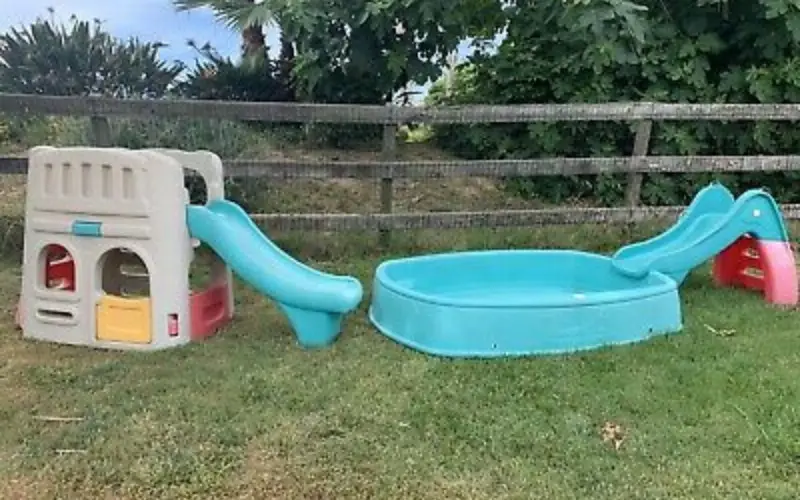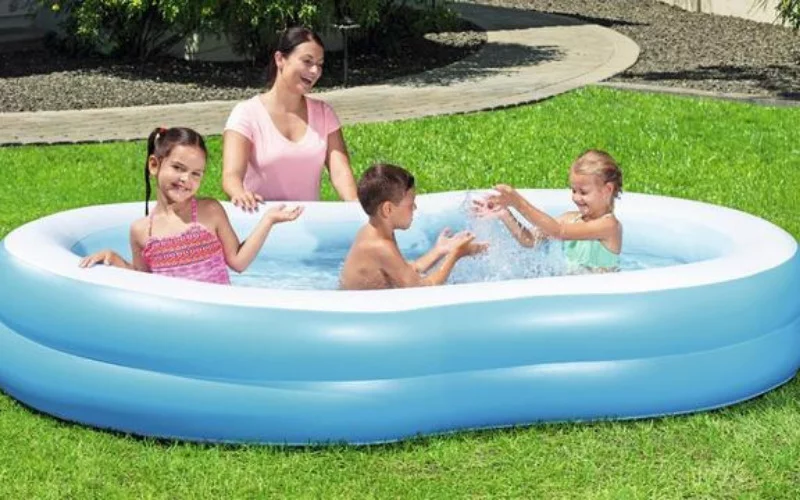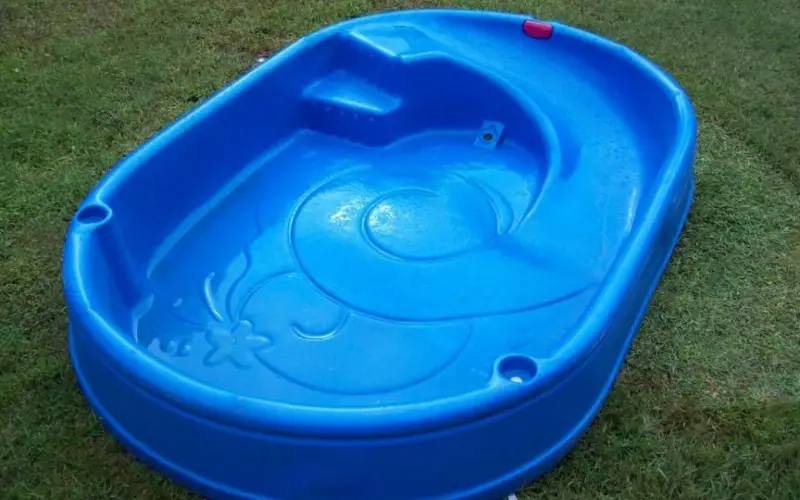A kiddie pool is a must-have for your kids every summer. Not only is it fun, but it is also relaxing. But if you want a change from the regular inflatable pool, you can always go for a plastic kiddie pool.
But how big is a plastic kiddie pool, how much water can it carry, what kind of plastic is used to make a plastic pool, and how deep is a plastic kiddie pool.
This article will discuss all you need to know about plastic kiddie pools, including their types and sizes. We will also recommend materials to put under a plastic kiddie pool.
Are Plastic Kiddie Pools Safe?
The safety of your kids while using a kiddie pool is important. On this note, you should know that hard plastic kiddie pools are made with different chemicals that are toxic to children.
When a child ingests these chemicals, it may have an adverse effect on their health, and some of these effects are known to be long-lasting.
Plastic made of polyvinyl chloride (PVC), popularly known as Vinyl, is one of the toxic chemicals used to make a plastic pool. It contains additives like phthalates, lead, and cadmium that are harmful to your child’s health.
Another toxic chemical is bisphenol-A (BPA); this chemical has been linked with cancer and affects the prostate gland and brains of children.
You should also consider that PVC is not eco-friendly as the production of this chemical serves as a pollutant to the atmosphere.
The knowledge of resin codes will help you determine which type of plastic to buy and the ones to watch out for as they contain dangerous chemicals.
- 1” = Polyethylene terephthalate or “PET,” which can be found in most plastic packaging.
- “2” = High-density polyethylene or “HDPE,” this can be found in toys, milk jugs, shampoo bottles, and grocery bags.
- “3” = Polyvinyl chloride or “PVC,” which is found in everything that has to do with plastic. Credit cards,
- “4” = Low-density polyethylene or “LDPE” a good example of products that contain this chemical is plastic bags and plastic rings used for holding canned drinks together.
- “5” = Polypropylene or “PP,” this can be found as automotive parts of vehicles made of plastic.
- “6” = Polystyrene or “PS,” this covers red solo cups, styrofoam, and other cafeteria materials.
- “7” = A category of “other” plastics, including acrylic, nylon, polycarbonate, and polylactic acid
Not all these resin codes are toxic; this means that we can feel safe with some of these chemicals included in the materials we buy. Some of the safe resin codes include.
- “2” = high-density polyethylene or “HDPE,”
- “4” = low-density polyethylene or “LDPE”
- “5” = polypropylene or “PP,,
You should look for these resin codes in your plastic kiddie pool; the other resin codes are toxic. But unfortunately, most of the plastic kiddie pool in the market contains PVC; look for one that says “BPA free” or “Phthalate free.”
Types of Kiddie Pool Plastic
There are two types of kiddie pools, hard plastic, and inflatable kiddie pool. People choose one of these kiddie pools because they both have their advantages and disadvantages. Here is a brief explanation of these types of kiddie pools and what they are known for.
Hard Plastic Kiddie Pool

Plastic kiddie pools are strong and sturdy and can be used by more than one kid at a time. It can also be used anywhere, and it is not very deep.
However, it doesn’t have a portable structure which makes it difficult to move from one place to another as it may crack in the process; you will also need enough space to store a plastic kiddie pool. You shouldn’t forget that plastic becomes weak when left under the sun for a long time.
Inflatable Kiddie Pool

An inflatable kiddie pool requires air to be used. It can be transported easily from one place to another and can even fit easily into your car.
An inflatable kiddie pool gives children the option to pick a style in various designs. You require only a small storage space for an inflatable kiddie pool.
There are some drawbacks to using an inflatable kiddie pool that might make you reconsider your choice. Inflatable pools are fragile and can tear up if left on a rough surface. You will always need a pump to ensure that your pool is inflated.
How Big is a Plastic Kiddie Pool?
Normally, the minimum diameter of a plastic kiddie pool is 2.5 feet, and a pool this size can contain just one toddler; there may not be enough wiggle space for two toddlers in a pool.
The size of the plastic pool you get relies on the age and size of kids using the pool, but there are three major sizes of a plastic kiddie pool, small, medium, and large.
Small Plastic Kiddie Pool
A small plastic kiddie pool is usually circular, and it has a diameter of 34.8”. These shallow pools are made of tough yet flexible plastic, they can carry 1 or 2 toddlers, and it’s a great way to introduce your kids to swimming or having a nice pool experience.
The Step 2 play & shade plastic kiddie pool is an excellent example of a small-sized pool. This classic pool comes with an umbrella to protect the delicate skin of your children.
Medium Plastic Kiddie Pool
A medium-sized kiddie pool has a diameter of. 36.75” and can be either circular or square in shape. There is not much difference between the small and medium kiddie pools as they both hold 1 or 2 kids; the major difference is that the medium-sized pool carries more gallons of water, and they vary in size.
These pools have a solid plastic rim and a slightly flexible bottom; this pool size is suitable for young or pre-school children learning how to swim. A great example of a medium-sized pool is the EverEarth beach blanket kiddie pool. This kiddie pool is safe and comes with a carry bag for easy transportation.
Large Plastic Kiddie Pools
These large kiddie pools are circular and have a diameter of 75” and above. It can accommodate 2 to 4 school kids, and it contains a lot of water.
These pools can even include the parents of the kids for a fun pool time, but you should endure that you have enough space in your yard to hold this large pool.
A pool like this is entirely made of hard plastic, and a good example is the Intex mini frame pool. This pool is just the right size for a family fun time outdoors.
A plastic kiddie pool can be as high as 156” in diameter, but it will be shallow compared to the smaller sizes.
How Many Gallons of Water can a Kiddie Pool Hold?
The amount of water a kiddie pool can hold depends on the size of the pool. A small-sized pool will hold less water than a large kiddie pool.
A small-sized kiddie pool can hold about 12 gallons of water, a medium-sized pool can hold about 22 gallons of water, and a large-sized pool can hold up to 200 gallons of water. The amount of water each pool can hold varies, and the size varies.
What kind of Plastic is a Kiddie Pool Made of?
A plastic kiddie pool can be made of various types of plastic, most of which we have explained earlier. They include PVC, polyethylene terephthalate, polypropylene, polystyrene, low-density polyethylene, and high-density polyethylene.
We have explained earlier that most of these plastics are toxic to your children and can cause serious health problems for them. They should be avoided. But plastic pools in which the amount of PVC has been drastically reduced can also be considered.
How Deep are Plastic Kiddie Pools?
Small plastic kiddie pools are shallow compared to large plastic kiddie pools that are reasonably deep. This feature also depends on the size of the pool being used.
But generally, plastic kiddie pools are not all that deep compared to inflatable kiddie pools that are considerably deep. Multiple people can use them for a great swimming experience.
What Do you Put Under a Plastic Kiddie Pool?
When using a plastic kiddie pool, there is no need to put any material under it; the hard plastic makes it stable and safe to keep on any surface. But if you still want to put the material under, you can use a plastic tarp.
However, an inflatable requires a thick gorilla pad to safely on some land surfaces. So if you have an inflatable, you should get a thick pad.
Conclusion
Kiddie pools are essential for your kids’ summer. So if you are looking for something solid and strong, you should consider purchasing a plastic kiddie pool. You should be cautious, though, as most of these pools are made with chemicals that can be toxic to your child’s health.
You should also learn about the different sizes of plastic kiddie pools, the amount of water they can carry, the number of individuals they can accommodate, and the space needed for the pool. If you want a shallow pool for your kids, you should buy a small or medium-sized plastic kiddie pool.
You May Also Like:
- Best Inflatable Pool Cleaner Tool
- Can You Set Up an Inflatable Pool on Concrete?
- How to Keep Inflatable Pool Water Clean With Salt
- Can I Put an Inflatable Pool on my Deck
- Best Ways To Clean The Kiddies Pool
We trust this article helped you know the Plastic Kiddie Pool Types And Sizes. You may also want to check out How To Keep A Kiddie Pool Clean
Thanks for taking the time to read our article, and we hope you find it helpful. Would you mind leaving a comment below if you have any suggestions?
Kindly reach out to people by sharing this post on social media.
If you liked this article, then please follow us on Facebook, Instagram, and Pinterest.

